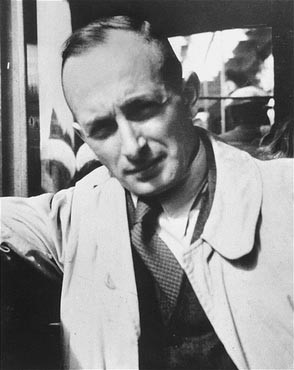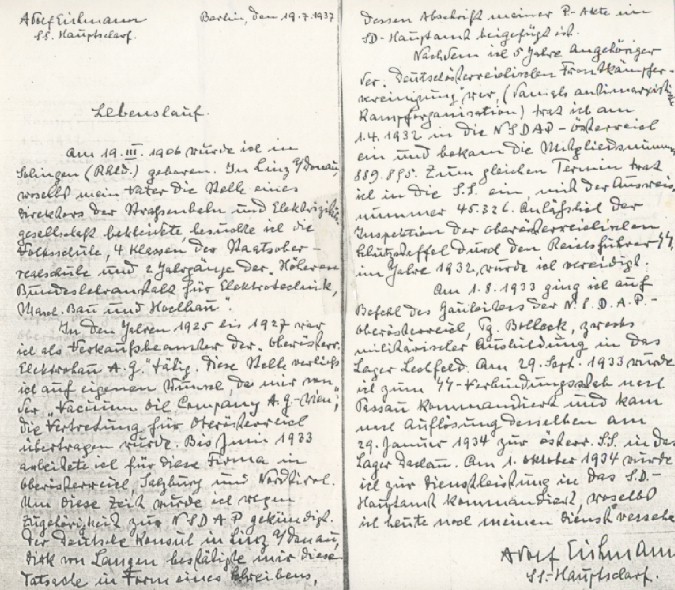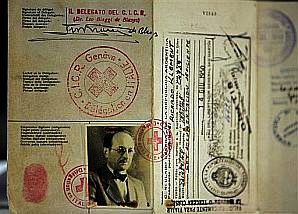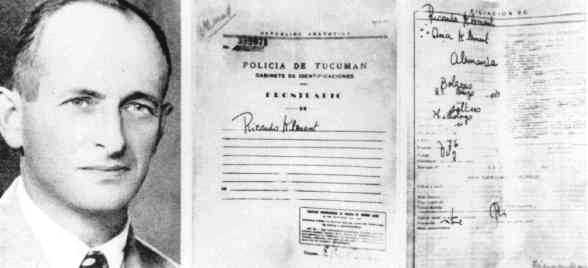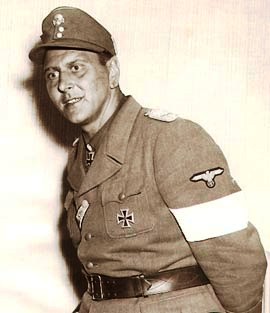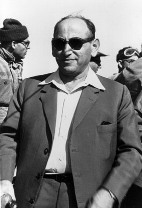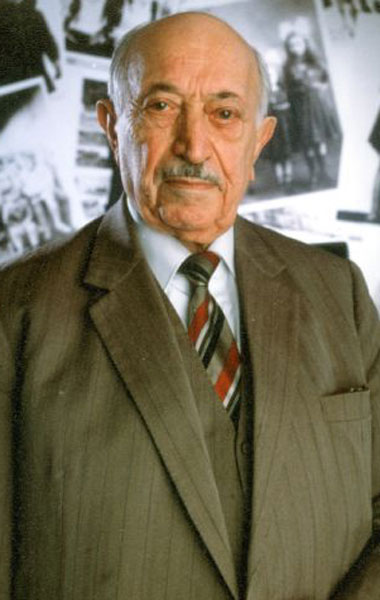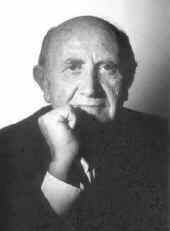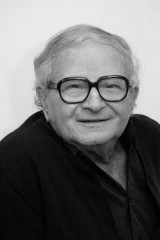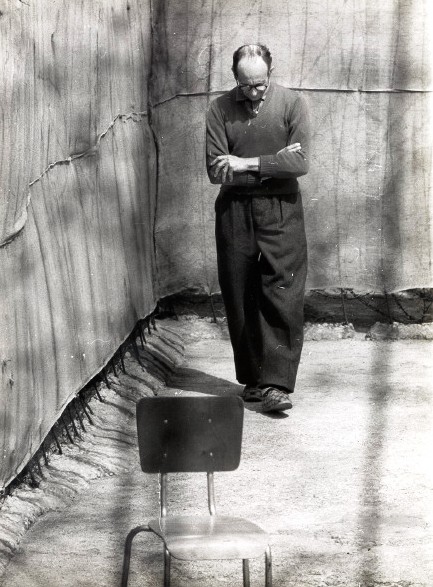Holocaust Education & Archive Research Team |
|
Trials Introduction to the Holocaust Trials
Trials
Interrogations & Testimonies
The IMT Series Nazi Justice
| ||||||
Adolf Eichmann His Escape and Capture in Argentina Operation Eichmann
End of the Third Reich
After the defeat of the Third Reich in May 1945 Adolf Eichmann, the RSHA specialist on Jewish matters, was arrested by the American forces near Ulm, along with his long-standing adjutant SS- Obersturmfuhrer Rudolf Janisch. The two men were taken to the prisoner of war camp at Weiden in the Upper Palinate.
At Weiden, POW camp Eichmann changed his identity with ease, he was arrested as a Luftwaffe Corporal Bart or Barth, then realising that officers were exempt from compulsory labour, he became SS –Untersturmfuhrer Otto Eckmann.
Eichmann and Janisch were moved to another camp at Ober- Dachstetten, in Franconia, Janisch was removed to another camp, fearful of discovery and alone Eichmann considered committing suicide.
The evidence provided by many former associates within the SS at the International Military Tribunal held in Nuremburg, meant that it was only a matter time before he was apprehended, and brought to justice, for his part in the destruction of European Jewry.
With the help of Senior SS officers in the camp he was provided with false documents which identified him as Otto Henninger from Breslau, travelled to Prien, where he was sheltered by a widow Nelly Krawietz , the sister of a former SS man in the Ober- Dachstettien camp.
Eichmann and Nelly Krawietz travelled to Hamburg, where they parted, Eichmann continued to the small town of Eversen, that stands on the great Luneberg Heath, where he lived and worked as a woodsman, for the next two years, before looking after chickens near Altensalzkoth.
Fearing the net was closing in on him Eichmann, left the chicken farm and like numerous Nazi fugitives followed the well established “rat line” that led from Germany, through Italy to Argentina.
In Hiding in Italy
At the beginning of 1950 Eichmann made contacts with ODESSA, the organisation of former SS men, who enabled him to flee to Italy, via monasteries.
Eichmann had been issued with an ID Certificate in the northern Italian town of Termemo in 1948, the ID was numbered 131 and bore the name Ricardo Klement, it was valid for two years, and this was probably the reason why he fled in 1950.
Armed with the forged ID and a Red Cross passport number 100940, which was issued in the Italian port of Genoa on the 1 June 1950, with the help of a Franciscan priest Father Eduardo Domoter.
To Argentina
Eichmann and two other former SS men boarded the SS Giovanni C which left Genoa to Buenos Aires, Argentina on the 17 June 1950, the ship docked in Buenos Aires on the 14 July 1950.
Eichmann secured employment with a construction company called CAPRI that specialised in hydro-electric power plants, in the remote province of Tucuman, from August 1950 to April 1953.
In December 1950 Adolf Eichmann wrote a coded message to his wife Vera, advising her in code that he was alive and well, and that she should make arrangements to join him in Argentina.
Vera, and the three Eichmann children Klaus, Horst and Dieter slipped away to Italy, and like the head of the family, boarded a boat in Genoa, the SS Salto, for Argentina. They disembarked in Buenos Aires in early July 1952, where they were met by Adolf Eichmann posing as their uncle Ricardo, Vera cried with joy on seeing her husband.
In spring 1953 CAPRI’s hydro-electric project in Tucuman collapsed and he moved himself and his family to a small house at 4261 Chacabuco Street in the Olivos district in Buenos Aires, where they lived for over six years.
Eichmann tried his hand at various jobs, a transport manager, a manger of an agora rabbit farm, a warehouseman and in March 1959 he obtained a job as welder and mechanic at the Mercedes Benz plant at Gonzalez Catan. The plant was located in a northern industrial suburb of Buenos Aires.
In 1953 Vera gave birth to a fourth son, who was named Ricardo Francisco Eichmann, whom Eichmann doted on, his three other sons regarded Eichmann as a strict father, but they admired his ability for dealing with practical issues, he could turn his hand to anything.
Eichmann maintained various friendships with former SS comrades who had also escaped to Argentina, one of them Otto Skorzeny, and it was through Skorzeny that Eichmann met Wilhelm Sassen, half –Dutch, half- German who had served in the Waffen-SS during the war.
Sassen a journalist met with Eichmann over a five month period during 1956 and recorded sixty-seven tape reels, which produced a script of 695 pages, covering the Final Solution and Eichmann’s role in it. The project though ended with Eichmann dissatisfied over Sassen’s less than faithful transcriptions so he started to make a handwritten version. Extracts of the Sassen version was published in Life Magazine.
In 1958 Eichmann bought a plot of waterlogged land in the Bancalari district of Buenos Aires, and with his sons built a house, which bore the address 14 Garibaldi Street.
Just as Eichmann thought in his new remote dwelling, he was more secure, the net was beginning to close in on him, from a source ironically close to home.
During 1956 Klaus Eichmann struck up a relationship with a pretty young woman Sylvia Hermann, whose father Lothar, had also settled in Argentina. But his path had been very different from Eichmann’s, as he was half-Jewish, and had fled Germany in 1938 after being incarcerated in a Nazi concentration camp.
Lothar Hermann conversed with Klaus Eichmann but then the family moved away, but Lothar spotted a newspaper article about the impending war crimes trial in Frankfurt, and Eichmann’s name appeared in the article. Surmising that Klaus Eichmann was the son of Nazi war criminal Adolf Eichmann, he took decisive action.
Lothar Hermann wrote to the judicial authorities in Frankfurt, who passed on the letter to Fritz Bauer, the Attorney General of Hesse, a former a concentration camp prisoner, who had fled first to Denmark, and then Sweden, after the Germans invaded in 1940.
Bauer sent all the information he had to the Israeli Foreign Ministry, Walter Eytan, the Director General of the Foreign Ministry, arranged a meeting with Isser Harel, the Director of the Israeli Secret Service.
Though Israel was a new nation, it had already developed a skilled intelligence service. A special unit of that service was called Mossad. The unit was formed to track down and kill enemies of the state, but dedicated its first few decades to the capture of terrorists and war criminals. The head of Mossad, Isser Harel, immediately took charge of the hunt for Eichmann.
He chose a special team of 30 agents, several of them survivors of the Holocaust, to assist in the operation. The Israeli government decided that Eichmann should not be assassinated, bu brought back to Israel to stand trial. To further complicate the matter, once Eichmann was found, he would have to be kidnapped and smuggled to Israel, a violation of Argentinean legal sovereignty.
Because many Nazi sympathizers found refuge in South America during the war, the Israelis knew that a diplomatic extradition would be difficult, if not impossible, to obtain. Harel overcame his initial scepticism to send a Secret Service agent to see Bauer personally in West Germany, this was achieved on the 6 November 1957, and Bauer gave this representative Eichmann’s address.
In April 1959 Simon Wiesenthal noticed an obituary notice for Frau Maria Eichmann in a Linz newspaper, and amongst the mourners was listed Vera Eichmann, in addition to this in February 1960 a newspaper carried the death notice of Eichmann’s father Adolf Karl, and Vera Eichmann and the boys were listed amongst the mourners.
Wiesenthal also passed this latest information onto the Israeli’s who were now pursuing Eichmann with a lot more vigour. Zvi Aharoni, a Mossad agent went to West Germany to look at Eichmann’s file, and Harel consulted with David Ben Gurion about the news that Eichmann was alive and living in Argentina, Ben Gurion agreed that it would probably be provident to achieve this covertly, kidnap Eichmann and bring him to Israel to stand trial.
The Identification of Adolf Eichmann
Zvi Aharoni flew to Buenos Aires arriving on the 1 March 1960 with false papers and made contact with some workmen at Eichmann’s old address on Chacabuco Street, but drew a blank. Aharoni next steps were to deliver a present via a “local messenger” to Nikolas Klement at the Chacabuco address, the workmen suggested that the person should contact Tito who had once lived at the address, and was working locally.
Contact was made with Tito who confirmed the present could have been for his father or his brother, and had given the lighter to his brother, and at the same time had provided precise directions on where Eichmann lived.
Aharoni drove along Route 202 and found the one storey house, flat roofed house, and on the 16 March he tried to photograph the house and its occupants, posing as American property developers, but this risky venture failed.
Aharoni instructed two his local volunteers on Sunday the 3 April 1960 to try and engage Eichmann in conversation, as he worked in the garden. With the precious photographs developed locally, Aharoni had them in his possession when he flew back to Israel via Europe.
The Capture
Harel was now setting the wheels in motion to capture Eichmann, he had appointed a senior intelligence officer Rafi Eitan, to lead the task force. At the end of April Aharoni and four other Mossad agents arrived in Argentina. Over the next fortnight more Mossad agents arrived, including a doctor, a forger and a technician who was an expert in safe houses, constructing cells etc.
Harel flew to Argentina at the beginning of May 1960, after seeing David Ben Gurion, for a final briefing, to head this historic mission, which was fraught with danger.
Initially the task force maintained surveillance of Eichmann’s family home, and established the daily pattern of Eichmann’s movements. They were able to establish that the bus dropped him off at 7.40pm, every workday evening. Eichmann left the bus every day in the dark, and made his way to his house on Garibaldi Street, along a deserted street.
On Wednesday 11 May 1960 the task force took up their positions around Eichmann’s house, two cars were waiting, one in Garibaldi Street itself, whilst another was parked nearby, partly concealed by a railway bridge. The car in Garibaldi Street contained the members of the “snatch squad,” Ahahoni was at the wheel, with him were Rafi Eitan, Zeev Keren and Peter Malkin.
The bus was late that day, at around 8pm it arrived and Eichmann stepped off the bus, unaware of what was to follow, and that his long period as a fugitive from justice was about to end.
Keren simulated a break down and raised the bonnet of the car, as Eichmann approached, Malkin pounced on him and in the struggle that followed the pair the pair fell over and toppled into a ditch by the side of the road. Eichmann screamed like a wounded animal, struggling violently, but he was overpowered as the snatch team re-grouped to bundle him into the car.
Eichmann was pushed onto the floor at the rear of the car, and bound and motorcycle goggles covered with tape were placed over his eyes. The car drove off at speed, Eichmann was covered with a blanket, and Eichmann was warned not to resist further, and he replied, “I have already accepted my fate.”
Eichmann was driven to a safe house, examined by a doctor, just in case Eichmann had poison, dressed in pyjamas and the initial interrogations commenced. After some hesitation and lies Eichmann confirmed his true identity, and after a few days Eichmann agreed to stand trial in Israel, after first stating he would only stand trial in Argentina or Germany.
On the 20 May 1960 Eichmann was drugged by the doctor and driven to the Ezeiza Airport supported by two Mossad agents, the plan was to switch Eichmann with a steward on the El-Al flight that had arrived the day before bringing the Israeli representatives to the Argentinean independence celebrations.
The car was waived through security, the Mossad agents wearing flight crew uniform aroused no suspicions, Eichmann was half-carried onto the aircraft, and strapped into a seat.
The aircraft a four-engineered Bristol Britannia took off just before midnight on the 20 May 1960. Following a stop at Dakar for re-fuelling and at 7.35am on the 22 May 1960, Adolf Eichmann set foot on Israeli soil, to face justice.
Sources:
Eichmann –His Life and Crimes by David Cesarini published by W. Heinemann 2004 Nizkor Yad Vashem Israel Government Press Office
Copyright Victor Smart H.E.A.R.T 2009
|
